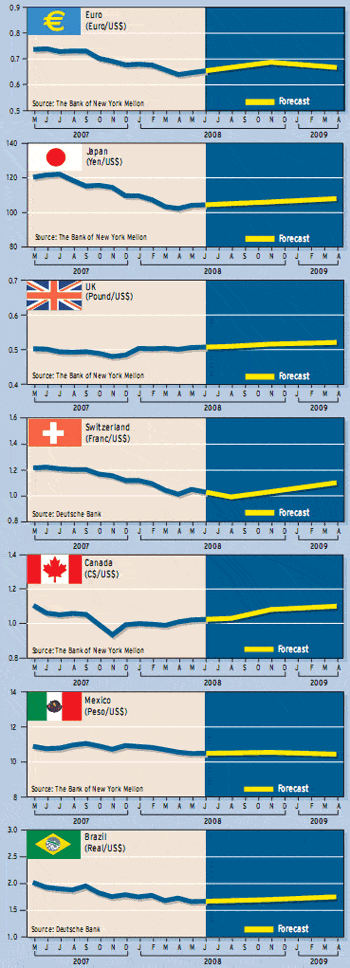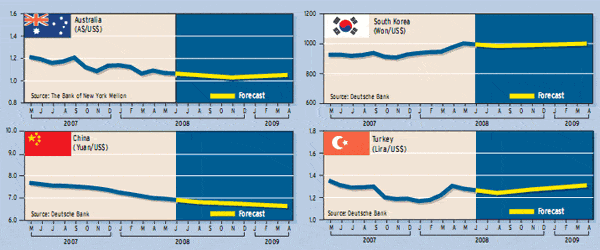FOREIGN EXCHANGE
A slew of poor economic indicators from the eurozone, including a surprising decline in retail sales in March, released in early May, supported the belief that Europe won’t escape the economic difficulties being felt in the United States, says Mark Frey, head trader at Custom House, a global payments company and foreign exchange dealer based in Victoria, British Columbia, Canada.
Industrial orders in Germany also declined in March, and the French trade deficit widened. Meanwhile, it was the smaller members of the EU that bore the brunt of the declines in retail sales, with Slovenia, Portugal and Luxembourg sustaining the biggest drops in spending, according to Frey. “This is one trend that we see as a potential problem for the EU, as the economic goals and prospects of the French and Germans clash with the smaller nations that aren’t experiencing the same inflationary pressures,” he says.
The conclusion to be drawn is that the ECB is prepared to raise interest rates if second-round effects from elevated energy and food prices begin to emerge, Woolfolk says. “Trichet threw a bucket of cold water on the dollar’s rally by erasing any hopes for a rate cut later this year and giving players every reason to believe the next move may be higher,” he says.
CURRENCY FORECASTS
 |
The Bank of England left its key interest rate unchanged at 5% in May, as expected, opting not to make back-to-back monthly cuts to help stimulate economic growth as inflation remained high. “The bank is widely expected to stick to its pattern of cutting rates in alternating months, thus reducing rates in June to 4.75%,” says Ashraf Laidi, chief foreign exchange strategist at CMC Markets US, based in New York. “We continue to expect [UK rates to decline to] 4% by year-end,” he says. The pound is expected to maintain its predominantly weak tone against the other major currencies, he predicts.
Hoenig’s remarks reinforced the view that there is little scope or appetite for additional rate cuts, says Marc Chandler, global head of currency strategy at Brown Brothers Harriman, based in New York, adding that “more pieces of the more-positive dollar puzzle are falling into place.” The relaxation of Fannie Mae’s lending limits and reports that the Fed is seeking Congressional approval to pay interest on reserves held by commercial banks point to the use of non-interest-rate mechanisms aimed at preventing a more serious downturn in the economy, according to Chandler.
“We do believe that the ECB will ultimately have to cut rates to counter slower-than-expected growth,” Chandler says. “Our view of a dollar recovery was partly based on US developments, like the economic downturn being short and shallow, and also was based on developments [in economies] abroad deteriorating more than was generally appreciated,” he says.
David Gilmore, partner and economist at Foreign Exchange Analytics, based in Essex, Connecticut, says the US administration’s view of the dollar changed ahead of the April meeting of the Group of 7 finance ministers of the major industrialized nations. The US Treasury and the White House felt that the weak dollar was doing all it could to help growth by making exports more competitive, but that continued weakness in the greenback risked worsening inflation, particularly in light of the connection between the dollar and the price of oil and other commodities, Gilmore says.
It is a safe bet that the US administration does not want to see a sharply higher dollar and that what it is seeking is stability, according to Gilmore. The April G-7 communiqué expressed concern about sharp fluctuations in major currencies.
“The ECB is still Zeus atop Mount Olympus, the great protector of price stability, punishing those demanding a growth-oriented monetary policy,” Gilmore says. “It is ironic that the US has embraced the notion, after several years of urging, to put an end to the dollar’s decline, and yet the ECB is a no-show when it comes to introducing downside risks for interest rates in the eurozone,” he says.
CURRENCY FORECASTS
 |
Gordon Platt



